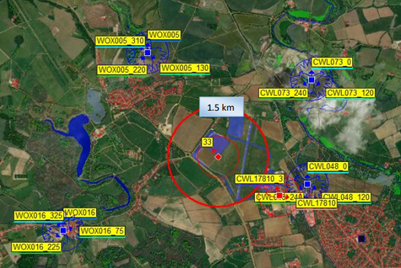Like many industries, the US Department of Defense understands how 5G really is. This is a direct result of its high performance, support for security requirements and ability to assist data-driven applications and M2M communications. The DOD is the largest user of the federal spectrum in the US and works with NTIA and FCC to develop policies to enable the spectrum to support emerging 技术. They recognize that technology advances will drive spectrum uptake and, as a result, they need to ensure that they protect access to this vital resource for future military capabilities. As an early 5G adopter, the DoD is hosting a series of experiments and demos as a testbed for potential uses. They need to understand the mitigations required to operate at given frequencies and within given constraints.
One aspect is this work is underway at Hill Air Force Base (AFB). At Hill Air, the Air Force is evaluating the impact of 5G systems on airborne radars, and vice versa, in the mid-band spectrum. The aim is to develop techniques to use spectrum dynamically and enable radars and 5G systems to coexist. The DoD evaluates how 5G wireless networks and high-power radars can function in the same or adjacent spectrum bands. To understand this, the DoD is operating testbeds to understand the dynamics of 5G and radars and the potential interference between the systems. Based on interference measurements and analyses from this testbed, dynamic spectrum utilization 技术 are being developed and evaluated. DoD will extend and enhance these findings to optimize spectrum use across a full range of military operational needs. [1]
A similar coordination study is underway in the UK. The national regulator Ofcom, specifies the thresholds and coordination procedure to protect existing radars in the 2.7GHHz band from harmful interference from deployments in the 3.4 GHz.[2]
Notably, in an earlier award in the 2.6GHz band, the UK Government implemented a radar remediation program to ensure ATC radars in the 2.7GHZ band were modified to be more resilient to interference from the 3.4GHz band. However, with over 50 protected military radars and 38 civil radars potentially impacted by the 3.4GHz deployments, Ofcom has outlined a series of thresholds to be met before deployment. The protected thresholds cannot be exceeded in any pointing direction of the protected radar antenna, and field strengths must not exceed the threshold limits for OOB emissions. Ofcom specified the propagation model ITU-R P.452-16 to predict signal levels for a given percentage of time using 50m DTM and clutter. This propagation model calculates the communications signal and the out of band noise at the relevant Protected Radar location(s). MNOs need to confirm that threshold(s) have been met, then deployment can proceed.
During their 5G network rollout, a leading MNO noted that some of their 5G towers fell within the 7km distance from an ATC radar. These radars typically operated at 2.7-3.10GHz while the 5G network operated at 3580-36080 MHz band. Due to the close proximity of the two systems, it was expected that the 5G transmission could interact with the nearby radar and compromise security. The studies focused primarily on 20MHz of spectrum for 5G transmission, due to a partial overlap.

To comply with Ofcom's regulations, a methodology was applied to support calculations. Broadly, this included:

Sites that failed the Ofcom criteria were then processed to identify potential mitigation measures. These included replacing the omni (peak-gain) antenna with a beamforming antenna pattern, reducing the bandwidth of the offending sectors, and de-activating the offending sector. Notably, sectors that failed to meet the OOB noise limit can only be de-activated. Whereas sectors that only fail the in-band criteria can be mitigated by retracting the transmission bandwidth to 3600-3680 MHz.

Conclusion:
Radars play a critical role in national security, air traffic control, weather warnings, and other safety of life applications. Typical characteristics of radars like high transmitter peak powers, or sensitive designs of receivers, have resulted in exclusive or primary spectrum allocations for radar operations in selected bands. However, with the demand for radio spectrum growing, significant chunks of the spectrum have been reallocated for emerging 技术 that could impact the successful operation of radars. Focus has turned to the military applications which come under threat. These support vital air defence systems used to target detection, recognition and weapon control. Protecting these valuable resources is essential and requires a good understanding of radio propagation, interference analysis and mitigation techniques.
To support this high level of radio propagation modelling, military and civil operators turn to spectrum engineering tools to calculate the impact and identify mitigations.
ATDI supply frequency assignment and spectrum management solutions to defence and security organisations. These solutions exploit spectrum-dependent systems, including communications links, electronic warfare sensors, radio jammers and radars.
Catch up with our latest webinar on Managing 5G interference into ATC Radars
[1] https://www.cto.mil/wp-content/uploads/2020/12/DOD-5G-Strategy-Implementation-Plan.pdf
[2] https://www.ofcom.org.uk/__data/assets/pdf_file/0017/114263/3.4-MoD-Co-ordination.pdf